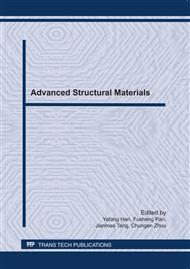p.727
p.733
p.740
p.745
p.752
p.758
p.765
p.770
p.778
Encapsulating and Manufacture Technology Study of Impact-Resisting, Enclosed Soft Aramid Vesicle
Abstract:
In order to get a soft and enclosed vesicle which can endure an instantaneous high temperature and super high pressure the soaking technology of aramid fiber with Room Temperature Vulcanization silicon rubber and liquid polyurethane was studied. Then the performance of the composites was tested. Two kinds of rubber vesicle were made, one with metal valve and another without the valve. Using three-dimension braid method, aramid fiber vesicle was made outside the rubber vesicle. Compression test results of the composite vesicle showed that no-valve rubber vesicle had a good match with the aramid one and endured a very large pressure. It can transfer the liquid pressure from inner vesicle to the outer one, which the aramid fiber has excellent mechanical performance and can endure a very large compression.
Info:
Periodical:
Pages:
752-757
Citation:
Online since:
June 2011
Authors:
Keywords:
Price:
Сopyright:
© 2011 Trans Tech Publications Ltd. All Rights Reserved
Share:
Citation:


